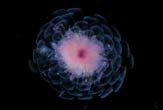Rich Gallery of Deep-Sea Life Discovered in Bermuda Triangle

The quantity and diversity of tiny creatures found in a deep-sea survey in the Bermuda Triangle region of the Atlantic Ocean is amazing scientists.
During a 20-day cruise last month, researchers used trawling nets and scuba divers to explore down to 3 miles beneath the ocean surface. Previous studies of small ocean creatures focused only on the top half-mile or so.
Several of the animals—tiny zooplankton, shrimp-like things, little squid, bizarre worms and pulsing jellyfish—are featured in a new image gallery.
SEE THE IMAGES
Among more than 1,000 different organisms collected, the project found "what appear to be several undescribed species that may well prove new to science," said the cruise's scientific leader Peter Wiebe of the Woods Hole Oceanographic Institution.
The results were announced today.
Perception 'radically altered'
The expedition has provided a new understanding of the diversity of gelatinous zooplankton, which the researchers describe as "the gooiest, stickiest, and most transparently fragile animals of the sea." They are rarely captured without being destroyed.
Sign up for the Live Science daily newsletter now
Get the world’s most fascinating discoveries delivered straight to your inbox.
Researchers want to know what's down there and what the various species are like. This will help them better understand the food chain and also gauge ocean health with similar surveys in the future. Hundreds of the captured critters were analyzed onboard the research ship using DNA barcode technology, which reveals differences in species.
The cruise was part of a larger project to make a global inventory of zooplankton by 2010. It's called the Census of Marine Zooplankton (CMarZ).
"We are just starting to realize how little we know about species variety," said Ann Bucklin, a University of Connecticut marine scientist who leads CMarZ. "We used to think we knew many species well, but the advent of DNA barcoding has radically altered that perception. Genetically distinctive species of zooplankton are being found with increasing frequency."
A bug's life
Zooplankton serve a vital role in combating global warming.
They spend their days in the deep and then commute more than a third of a mile to the surface each night to feed on carbon-absorbing plants called phytoplankton. The zooplankton then carry the carbon from the surface to the depths, effectively sequestering it from the atmosphere, where it acts as a greenhouse gas.
The tiny creatures also help feed humans. Here's a rough idea of how researchers think the food chain works:
Some 10,000 pounds of phytoplankton is consumed by 1,000 pounds of zooplankton, which in turn support 100 pounds of larger zooplankton, which become meals for 10 pounds of small fish species like herring or anchovies, which support 1 pound of a larger fish species that might end up on your dinner table.
Some birds and whales eat zooplankton, too.
"By 2010, the research conducted by this project will provide a baseline against which future generations can measure changes to the zooplankton and their provinces, caused by pollution, over-fishing, climate change, and other shifting environmental conditions," Bucklin said.
- GALLERY: See the Deep-Sea Creatures
- Secret Lives of Deep-Sea Beasts Revealed
- Five Deep-Sea Fish on Brink of Extinction
- Ice Shelf Collapse Reveals New Undersea World
- Elusive Giant Squid Finally Photographed
Robert is an independent health and science journalist and writer based in Phoenix, Arizona. He is a former editor-in-chief of Live Science with over 20 years of experience as a reporter and editor. He has worked on websites such as Space.com and Tom's Guide, and is a contributor on Medium, covering how we age and how to optimize the mind and body through time. He has a journalism degree from Humboldt State University in California.











